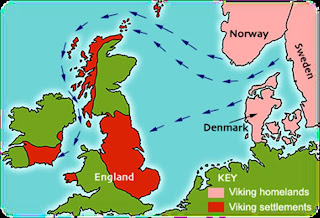The Viking age in European history was about AD 700 to 1100. During this period many Vikings left Scandinavia and travelled to other countries, such as Britain and Ireland. Some went to fight and steal treasure. Others settled in new lands as farmers, craftsmen or traders.

Vikings occupied and had control over large extension of land in the north and east of England, which is called Danlaws For 500 years, Vikings ruled the north of Scotland, the Orkney and Shetland isles and the Hebrides islands off the west coast. In Ireland, Vikings founded the city of Dublin.
In the Old English was very important the influence of the Scandinavian words introduced during the Viking invasion of the IX and X century.The Vikings spoke Old Norse which is very similar to Old English because they had the same roots in the Proto-German language. When these two languages joined, it created a mixed language: Old English with borrowed words of Vikings belong to different lexical fields:
Nordic | English | Spanish |
Ancaire | Anchor | Ancla |
Seol | Sail | Navegar |
Vindauga | Window | Ventana |
Margadh | Market | Mercado |
Brog | Shoe | Zapato |
Baggi | Bag | Bolso |
Bathir | Both | Ambos |
Kalla | Call | Llamada |
Drit | Dirty | Sucio |
Gaman | Game | Juego |
Husbondi | Husband | Marido |
Knifr | Knife | Cuchillo |
Lagu | Law | Ley |
Mistaka | Mistake | Error |
Oddi | Odd | Impar |
Reisa | Raise | Aumento |
Steik | Steak | Filete |
Uggligr | Uggly | Feo |
Skata | Skate | Patín |
oaf | elf | duende |
Hitta | Hit | Golpe |
birdr | Birth | Nacimiento |
The relationship between both languages is so intimate that not only lexical items, but also certain grammatical structures, word endings and the so-called structural words were taken from Old Norse.
They introduced the pronoun they and the verb form are.
Many place-names have Old Norse suffixes such as: -thorp (place secondary to a –by), -by (new settlement. As a rule, they are relevant places), -thwait(e) (village smaller than a –thorp, normally in a clearing), -toft (settlement smaller than a -thwait(e)) and Grimston-hybrids (settlements that contain a Scandinavian person-name used before the eleventh century followed by the OE suffix –ton).
The prefixes be-, for- and with- were used to form many new verbs. New abstract nouns were formed from adjectives and substantives by the addition of the endings -ness, -hode , -hede and -ship; new adjectives in -sum, -ful, -lich (-ly); and new agent-nouns in -ere.
The ending -ing was more and more frequently added to verbs to form nouns of action, and, before the end of the fourteenth century, the derivatives so formed had come to be used as mere gerunds.
The suffix -liche (-ly) became a regular means of forming adverbs.
As the Old English endings -en and -icge, used to form nouns denoting persons of the female sex, had become obsolete, the French -esse was adopted, and added to native words, as in goddesse, fiendesse and sleeresse. In the southern dialect of the thirteenth century, there appears a curious abundance of feminine agent-nouns formed from verbs by adding the suffix -ild, of which there are one or two examples in Old English, though, singularly enough, they have been found only in Northumbrian. Instances of this formation from the Ancren Riwle are beggild a woman given to begging, cheapild a female bargainer, grucchild a female grumbler, mathelild a female
chatterer, totild a woman fond of peeping; other words of this formation which do not imply any disparagement are fostrild a nurse, and motild a female advocate.
Besides the feminines in -esse, the fourteenth century shows a few examples of the practice, which afterwards became so common, of appending Romanic suffixes to native words. Hampole has trowable for credible, Wyclif everlastingtee (after eternitee), and Chaucer slogardrie and slogardie (“sluggardry”), and eggement instigation (from the verb “to egg”).
No hay comentarios:
Publicar un comentario